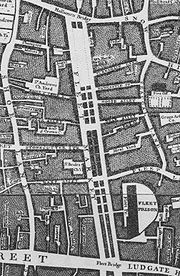
Fleet Market
Encyclopedia

River Fleet
The River Fleet is the largest of London's subterranean rivers. Its two headwaters are two streams on Hampstead Heath; each is now dammed into a series of ponds made in the 18th century, the Hampstead Ponds and the Highgate Ponds. At the south edge of Hampstead Heath these two streams flow...
. The market was located approximately where the modern Farringdon Street stands today, to the west of the Smithfield
Smithfield, London
Smithfield is an area of the City of London, in the ward of Farringdon Without. It is located in the north-west part of the City, and is mostly known for its centuries-old meat market, today the last surviving historical wholesale market in Central London...
livestock market.
Work began in 1734 to arch over the River Fleet, as it had become an open sewer; and to remove the considerable expense of clearing the river of rubbish and filth. The course of the river was covered between Holborn Bridge and Fleet Bridge (now Ludgate Circus
Ludgate Circus
Ludgate Circus is a location in the City of London at the intersection of Farringdon Street / New Bridge Street with Fleet Street/Ludgate Hill....
). The market, consisting of two rows of open one–storey shops linked by a covered walkway, opened on 30 September 1737. The market replaced the Old Stocks Market that itself had been cleared for the construction of the Mansion House
Mansion House, London
Mansion House is the official residence of the Lord Mayor of the City of London in London, England. It is used for some of the City of London's official functions, including an annual dinner, hosted by the Lord Mayor, at which the Chancellor of the Exchequer customarily gives a speech – his...
.
To the north of the market, vegetables were sold in an open air market. The centre was marked by a clock tower; and the south was adjacent to the Fleet Prison
Fleet Prison
Fleet Prison was a notorious London prison by the side of the Fleet River in London. The prison was built in 1197 and was in use until 1844. It was demolished in 1846.- History :...
.
By 1829, the market was dilapidated and considered an obstacle to the increasing volume of traffic; and was cleared for the construction of Farringdon Road
Farringdon Road
Farringdon Road is a road in Clerkenwell, Central London. Its construction, which took almost 20 years between the 1840s and the 1860s, is considered one of the greatest urban engineering achievements of the nineteenth century...
. Farringdon Market
Farringdon Market
Farringdon Market was a market erected in 1829 to replace the Fleet Market, which had been cleared for the widening of Farringdon Street and Farringdon Road. The market was between Farringdon Street east and Shoe Lane west, north of Stonecutter Street, in the City of London ward of Farringdon...
was constructed to replace it, but was never successful.

